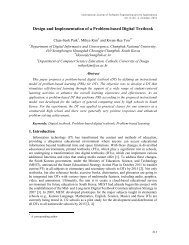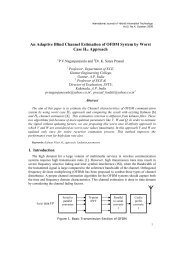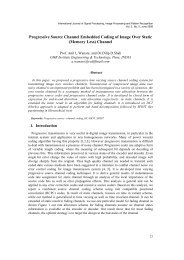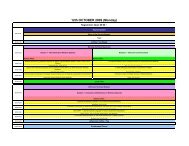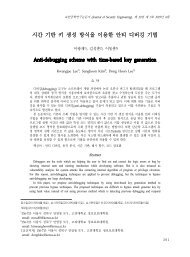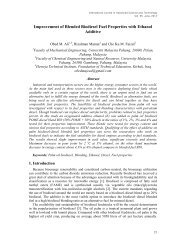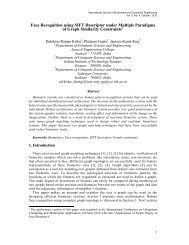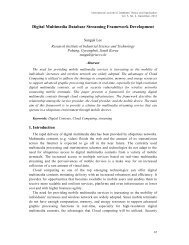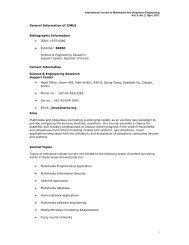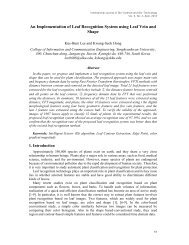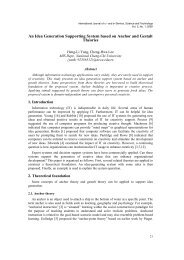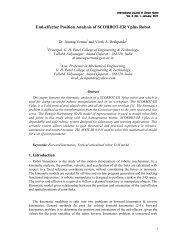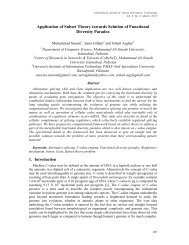Lane Detection using Fuzzy C-Means Clustering
Lane Detection using Fuzzy C-Means Clustering
Lane Detection using Fuzzy C-Means Clustering
Create successful ePaper yourself
Turn your PDF publications into a flip-book with our unique Google optimized e-Paper software.
International Journal of Multimedia and Ubiquitous Engineering<br />
Vol. 7, No. 4, October, 2012<br />
<strong>Lane</strong> <strong>Detection</strong> <strong>using</strong> <strong>Fuzzy</strong> C-<strong>Means</strong> <strong>Clustering</strong><br />
Kwang Baek Kim 1* , Doo Heon Song 2 and Jae-Hyun Cho 3<br />
1 Department of Computer Engineering, Silla University, Korea<br />
2 Department of Computer Games, Yong-in SongDam University, Korea<br />
3 Department of Computer Engineering, Catholic University of Pusan, Korea<br />
gbkim@silla.ac.kr, dsong@ysc.ac.kr, jhcho@cup.ac.kr<br />
Abstract<br />
In general, road lane detection from a traffic surveillance camera is done by the analysis<br />
of geometric shapes of the road. Thus, Hough transform or B-snake technology is preferred to<br />
intelligent pattern matching or machine learning such as neural network. However, we insist<br />
that the feasibility of <strong>using</strong> intelligent technique in this area is quite undervalued. In this<br />
paper, we first divide the image into halves and use only the lower part in detection and<br />
binarize them by analyzing RGB channel. Then the boundary lines are extracted by applying<br />
4-directional contour tracking algorithm and vectors with distance and angle values are<br />
extracted from those boundary lines to use as input for fuzzy C-means clustering algorithm.<br />
Clustered vectors form a straight line for road lanes by our method. In experiment, the<br />
proposed intelligent method is slightly slower than Hough transform but better in accuracy<br />
thus there is a room for intelligent method such as fuzzy C-means to solve this problem.<br />
Keywords: RGB channel, 4-directional contour tracking algorithm, <strong>Fuzzy</strong> C-means, Rroad<br />
lanes<br />
1. Introduction<br />
One of the frequent applications of image processing is ITS (Intelligent Transport System)<br />
<strong>using</strong> CC-TV [1]. One of the basic but important algorithms in such image analysis is lane<br />
detection. It is a basic building block of many traffic analysis applications such as lane change<br />
detection and collision detection. There has been a great deal of research into lane detection<br />
for operating intelligent vehicles. Hough transform that maps a line as an intersection point in<br />
the Hough area if it is translated to a coordinate system that has the relative rotation angle and<br />
distance from origin, i.e. the polar coordinate [2] and B-Snake technology [3] are two well<br />
known algorithms in this department. However, one may argue that these algorithms are<br />
basically based on the linear processing schemes. Recent trend in computing paradigm is to<br />
use MIMD with parallel processing in order to obtain maximum utility of resources such as<br />
cloud systems as an example.<br />
From that point of view, we argue that a system based on artificial intelligence such as<br />
fuzzy logic or neural network might be more efficient than linear systems in such<br />
environment even in low level ITS applications [4]. Such intelligent techniques have been<br />
mostly disregarded in problems such as lane detection since Hough transform or B-snake<br />
simply looks more efficient in linear processing environment.<br />
119
International Journal of Multimedia and Ubiquitous Engineering<br />
Vol. 7, No. 4, October, 2012<br />
2. <strong>Lane</strong> <strong>Detection</strong> <strong>using</strong> <strong>Fuzzy</strong> C-<strong>Means</strong> <strong>Clustering</strong><br />
We use 640 x 480 size 24 bit BMP format images as input. We first divide the image into<br />
halves and use only the lower part in detection and binarize them by analyzing RGB channel.<br />
The reason for <strong>using</strong> only lower half is that the upper part has only small portion of<br />
information about road lane thus it is inefficient considering the processing time. Road lanes<br />
are typically white or yellow thus we binarize them as such. Then the boundary lines are<br />
extracted by applying 4-directional contour tracking algorithm and pixels having value less<br />
than 100 are removed as noise. Figure 1 summarizes these preprocessing steps.<br />
Figure 1. Image Preprocessing Steps<br />
Input characteristic vectors are extracted by applying formula (1) having the distance and<br />
the angle for every 50 pixels.<br />
Disti(<br />
Pk<br />
mod 50,<br />
Pk<br />
mod 50 50)<br />
V { (1)<br />
i<br />
Angi(<br />
Pk<br />
mod 50,<br />
Pk<br />
mod 50 50)<br />
where P is the coordinates of boundary line. Figure 2 shows the vector extraction process.<br />
Figure 2. Feature Vector Extraction<br />
FCM clustering [5, 6], originally designed in 1973 by Bezdek, is a classification algorithm<br />
that enumerates degrees of cluster membership for each data based on the distance from the<br />
center point. The membership degree is represented by a number between 0 and 1 and the<br />
cumulated sum of dataset is 1. In formula (2), U ik denotes the membership degree of k th data<br />
belongs to i th cluster. The center of j th cluster is computed by formula (3). Then the new<br />
membership degree U ik (r+1) is computed by formula (4). The procedure is repeated until the<br />
difference between the new and old membership degree is smaller than the threshold value<br />
and as a result, input vectors are clustered as such.<br />
120
International Journal of Multimedia and Ubiquitous Engineering<br />
Vol. 7, No. 4, October, 2012<br />
U<br />
c<br />
<br />
i1<br />
U<br />
v<br />
ij<br />
1, k<br />
1, n<br />
ik ,<br />
<br />
n<br />
<br />
k1<br />
n<br />
( U )<br />
<br />
k1<br />
ik<br />
ik<br />
m<br />
( U )<br />
( r1)<br />
1<br />
ik<br />
<br />
c <br />
r<br />
<br />
dik<br />
r<br />
j1<br />
d<br />
jk<br />
<br />
x<br />
m<br />
kj<br />
<br />
<br />
<br />
2/ m1<br />
Figure 3 shows the plotting of input vector set into FCM.<br />
(2)<br />
(3)<br />
(4)<br />
Figure 3. Vector Graph<br />
Naturally, input vectors form a loosely coupled clusters as shown in Figure 3 since vectors<br />
from the same straight line(lane) have similar distance and angles. When we use FCM, we<br />
should provide the number of resultant clusters and it was 4 in this paper. Vectors are more<br />
clearly clustered after applying FCM as shown in Figure 4. Figure 5 shows the result of FCM<br />
comparing with the original image.<br />
Figure 4. <strong>Clustering</strong> Result<br />
121
International Journal of Multimedia and Ubiquitous Engineering<br />
Vol. 7, No. 4, October, 2012<br />
The original image (Figure 5 (a)) is divided into two parts and the lower half is binarized<br />
(Figure 5 (b)) and 4-directional contour tracking algorithm is applied (Figure 5 (c)) and the<br />
characteristic vectors are extracted (Figure 5 (d)) and FCM is applied to them as shown in<br />
Figure 5 (e).<br />
Figure 5. Original Image and Image after FCM<br />
3. Experimental Results and Analysis<br />
The software is written in Visual Studio 2005 on an IBM compatible PC with Intel<br />
Pentium-IV 3 GHz CPU and 1G RAM <strong>using</strong> images of 24 bit BMP format 640 x 480 in size.<br />
Figure 6. Experiment on the Number of Clusters<br />
122
International Journal of Multimedia and Ubiquitous Engineering<br />
Vol. 7, No. 4, October, 2012<br />
The main clustering algorithm FCM requires fixed initial number of clusters by nature.<br />
Although that is the main deficiency in this type of application, we use the number of clusters<br />
from 3 to 6 and compared them in Figure 6. Figure 6(b) has the number of cluster 3 and<br />
Figure 6 (c) has 4, Figure 6(d) has 5, and Figure 6(e) has 6.<br />
As shown in Figure 6, presetting the number of clusters is not a big problem in this<br />
application but for most cases, the two center lines are most important thus FCM <strong>using</strong> 4 as<br />
the number of clusters is most efficient in our experiment.<br />
4. Conclusions<br />
The common conception of applying intelligent algorithms such as fuzzy logic or neural<br />
network is finding an application that is not too much speed-sensitive and has less formal<br />
information like geometric characteristics. However, its possibility of adopting parallel<br />
processing schemes is another advantage for extending its usability.<br />
Our effort here <strong>using</strong> FCM in low-level ITS that has well deserved formal characteristics<br />
such as lane detection can only verify that the intelligent algorithm has been undervalued in<br />
such problems and it can be applied in real time as well if the environment allows (or<br />
requires) non-linear processing environment.<br />
Simple characteristic vectors extracted by image preprocessing are successfully clustered<br />
into a straight line without losing lane information even with partly disconnected real world<br />
road lanes in our experiment. However, the current method can only be applied to straight<br />
lines and produces some amount of false positive objects and these problems will only<br />
stimulate us to develop the next research.<br />
References<br />
[1] J. Palen, “The need for surveillance in Intelligent Transportation Systems”, Intellimotion, vol. 6, no. 1,<br />
(1997).<br />
[2] B. Yu and A. K. Jain, “<strong>Lane</strong> boundary detection <strong>using</strong> a multiresolution Hough transform”, Proceedings of<br />
International Conference on Image Processing, (1997) October 26-29, Washington, DC, USA.<br />
[3] Y. Wang, E. K. Teoh and D. Shen, “<strong>Lane</strong> detection and tracking <strong>using</strong> B-Snake”, Image and Vision<br />
Computing, vol. 22, no. 4, (2004).<br />
[4] W. S. Shin, D. H. Song and C. H. Lee, “Vehicle classification by road lane detection and model fitting <strong>using</strong> a<br />
surveillance camera”, International Journal of Information Processing Systems, vol. 2, no. 1, (2006).<br />
[5] K. B. Kim, J. H. Cho and C. K. Kim, “Recognition of passports <strong>using</strong> FCM-based RBF network”, Lecture<br />
Notes in Artificial Intelligence, LNAI 3809, (2005).<br />
[6] R. Babuska, “<strong>Fuzzy</strong> Modeling for Control”, Kluwer Academic Publishers, Norwell, MA, USA, (1998).<br />
Authors<br />
Kwang Baek Kim received his M.S. and the Ph.D. degrees in<br />
Department of Computer Science from Pusan National University, Busan,<br />
Korea, in 1993 and 1999, respectively. From 1997 to present, he is a<br />
professor, Department of Computer Engineering, and Silla University in<br />
Korea. He is currently an associate editor for Journal of The Korea<br />
Society of Computer and Information, and The Open Artificial<br />
Intelligence Journal (USA). His research interests include fuzzy neural<br />
network and application, bioinformatics and image processing.<br />
123
International Journal of Multimedia and Ubiquitous Engineering<br />
Vol. 7, No. 4, October, 2012<br />
Doo Heon Song received a BS degree in Statistics & Computer<br />
Science from Seoul National University and an MS degree in Computer<br />
Science from the Korea Advanced Institute of Science and Technology in<br />
1983. He received his PhD Certificate in Computer Science from the<br />
University of California in 1994. From 1983~1986, he was a researcher<br />
at the Korea Institute of Science and Technology. He has been a<br />
professor at the Department of Computer Games, Songdam College,<br />
Korea, since 1997. His research interests include ITS, machine learning,<br />
artificial intelligence, medical image processing, cognitive science, and<br />
game intelligence.<br />
Jae-Hyun Cho received the Ph.D. degrees in Computer Science from<br />
Pusan National University, Busan, Korea in 1998. From 2001 to present,<br />
he is a professor of Department of Computer Engineering at Catholic<br />
University of Pusan, Korea. He is currently a vice president of The Korea<br />
Society of Computer and Information. His research interests include<br />
image recognition, neural network and artificial vision system.<br />
124



